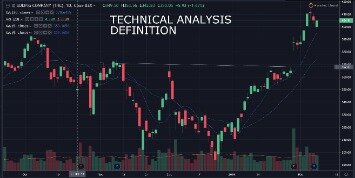Contents:


Get Started Learn how you can make more money with IBD’s investing tools, top-performing stock lists, and educational content. As the price moves lower, it starts to attract buyers interested in the lower price. Another trendline could also be drawn along the falling price to indicate when a bounce may be coming. That trendline would be have been penetrated near the middle of February as the price made a quick v-bottom and progressed higher. The offers that appear in this table are from partnerships from which Investopedia receives compensation. This compensation may impact how and where listings appear.
Buy or sell: Sumeet Bagadia recommends three stocks to buy on Monday Mint – Mint
Buy or sell: Sumeet Bagadia recommends three stocks to buy on Monday Mint.
Posted: Mon, 17 Apr 2023 19:38:59 GMT [source]
Other data, such as indicators and sentiment analysis, are considered secondary. The use of computers does have its drawbacks, being limited to algorithms that a computer can perform. Several trading strategies rely on human interpretation, and are unsuitable for computer processing. Only technical indicators which are entirely algorithmic can be programmed for computerized automated backtesting. Based on the premise that all relevant information is already reflected by prices, technical analysts believe it is important to understand what investors think of that information, known and perceived. For example, assume that the price of stock “A” has climbed steadily from $10 to $40.
Key Financial Statement Line ItemFinancial statements are written reports prepared by a company’s management to present the company’s financial affairs over a given period . Using K-Means and autoencoder methods to cluster the data, I plotted the medoid time-series below in Figure 10. I found that even using multi-channel data, we still get similar results — classes separated, largely, by opposite-sign harmonics. Figure 5 explores the correlation of the various groups with the various sectors.
Analyzing Market Trends
Significant events and the global economy can impact the asset price at any moment, but long-term price movement usually prevails despite what happens on the market. As we have mentioned earlier, intermediate trends are the time of correction. That means an asset’s price can go in any direction, even an unexpected one. It usually happens when you see a stock’s price making sudden rallies and turnarounds without establishing any clear uptrend or downtrend. Such a situation can last for several weeks or even months leaving traders embarrassed . All of these areas are interconnected, as expected future conditions shape current decisions, which, in turn, create current direction of trends.
- In this case, various tools are used — they are called ‘trend analysis indicators’.
- Rallies in a bull market are strong, while reactions are weak.
- A support line represents a stock price low maintained over a defined time frame, while a resistance line represents a stock price high maintained over a defined time frame.
- Trend analysis can have some potential disadvantages as a tool for making investment decisions.
It can then be used by academia, as well as regulatory bodies, in developing proper research and standards for the field. The CMT Association has published a body of knowledge, which is the structure for the Chartered Market Technician exam. Other pioneers of analysis techniques include Ralph Nelson Elliott, William Delbert Gann, and Richard Wyckoff who developed their respective techniques in the early 20th century. More technical tools and theories have been developed and enhanced in recent decades, with an increasing emphasis on computer-assisted techniques using specially designed computer software. Once again, you never actually have to do any of these calculations.
First Red Day
This post was prepared for informational purposes by the Artificial Intelligence Research group of JPMorgan Chase & Co and its affiliates (“J.P. Morgan”), and is not a product of the Research Department of J.P. J.P. Morgan makes no representation and warranty whatsoever and disclaims all liability, for the completeness, accuracy, or reliability of the information contained herein. As depicted in Figure 7, monochromatic waves resemble cosine waves of different frequencies. Note that in the left plot of Figure 7, the line widths are weighted by the cluster population, while in the right plot, line widths are weighted by the cluster’s average potential profit. From these plots, we can see that all four clusters have a similar population and that there is very little difference in each cluster’s average potential profit.
Prices do not change chaotically — their volatility is conditioned by a multitude of factors. This guide will teach you to discern these tendencies and perform market trend analysis for crafting a reliable trading strategy. A common way to identify trends is using trendlines, which connect a series of highs or lows . Uptrends connect a series of higher lows, creating a support level for future price movements. Downtrends connect a series of lower highs, creating a resistance level for future price movements. In addition to support and resistance, these trendlines show the overall direction of the trend.
Technical analysis utilizes the information captured by the price to interpret what the market is saying with the purpose of forming a view of the future. Technical analysis attempts to turn past patterns of price movements into a prognostication about future price movement. Learn about how to turn these returns expectations into profitable trading. If the price closes above the weekly average, the market will continue to move up for quite a long time afterward, in the opposite case — the market will experience a downtrend. Despite its reliability, the Moving Average indicator can be lagging, which makes it less suitable for medium time frames and short-term trading. If the price has been moving in the same direction for several weeks, the trader will notice that support and resistance levels are forming on a 4-hour or daily chart.
Trading with Mixing Indicators
An https://trading-market.org/ line is a straight line drawn upward to the right that connects 2 or more low points. The second low must be higher than the first for the line to have an upward incline. Uptrend lines act as support and indicate that there is more demand than supply, even as the price rises.

Charles Dow believed that prices moved in waves or trends. He believed that much like a rising tide where the waves would move farther up the beach with each ebb and flow, and cause smaller ripples, so too would rising stock prices. Conversely, once the tide had peaked and changed to move farther down the beach until low tide, so too would stock prices. This may seem like a simple concept, but it is part of the foundation of the modern study of trends in stock prices.
Stock Market Trends: 3 Steps to Find Leading Stocks
Sector analysis to identify the strongest and weakest groups within the broader market. Technical analysis can be as complex or as simple as you want it. The example below illustrates some basic principles of chart analysis. Since we are interested in buying stocks, the focus will be on spotting bullish situations in this chart. I became a self-made millionaire by the age of 21, trading thousands of Penny Stocks – yep you read that right, penny stocks. When it comes to the stock market, there are no guarantees.
Sigma Planning Corp Acquires Position in PENN Entertainment, Inc … – Best Stocks
Sigma Planning Corp Acquires Position in PENN Entertainment, Inc ….
Posted: Fri, 14 Apr 2023 07:40:00 GMT [source]
Fibonacci was a 12th-century mathematician who developed a series of ratios that is very popular with technical traders. Fibonacci ratios, or levels, are commonly used to pinpoint trading opportunities and both trade entry and profit targets that arise during sustained trends. Daily pivot points and their corresponding support and resistance levels are calculated using the previous trading day’s high, low, opening and closing prices.
Thus a method named the triple barrier method can be well used in this situation.The triple barrier method is put forward by Marcos for the first time, which is an alternative labelling method (see in Fig. 1). These include relative strength analysis, trend, consolidation, support, resistance, and change in polarity. Technical analysis is a form of security analysis that uses price data and volume data, typically displayed graphically in charts. The charts are analyzed using various indicators in order to make investment recommendations. Until the mid-1960s, tape reading was a popular form of technical analysis.
Trend vs. correction. How to distinguish the trend reversal from the correction?
The counterpart, stock market trend analysis loss, is defined as the amount lost when investing $100 and selling at the lowest point in 20 days. In considering the bull flag chart pattern alone then, these two separate research papers find that one can make a profit, on average, by leveraging chart patterns. However based on the training set of XGB-HMM and the test set results, we can see that the three states and the ups and downs of stock price are not relatively consistent. For example, when the stock price reaches a local maximum and starts to fall, the state is still red, and it is green after a few days.
Many of the principles applicable to support and resistance levels can be applied to trend lines as well. The descending triangle is a chart pattern used in technical analysis. The pattern usually forms at the end of a downtrend but can also occur as a consolidation in an uptrend.
A simple moving average line equals the sum of all the prices of a stock over a given time, divided by that time frame. Some standard moving average time frames are 20, 50, and 200 days. Heavily-traded stocks allow investors to trade quickly because there are many buyers and sellers. Thinly-traded stocks are more difficult to trade because there are few buyers or sellers. So, if you’re trying to trade a thinly traded stock, you may have to change your entry or exit price considerably to make a trade.
In this article, I’ll break down trend analysis, how and why to use it, as well as how to identify and predict trends for yourself. I’ll also share some essential trend analysis tips for day traders. Now, as we explored the theory, let’s move on to the practical part. You don’t need to possess huge trading experience to spot trends in the stock market. The market analysis boils down to tracking the dynamics of price highs and lows.
In addition, it measures the relative performance of major equity benchmarks around the globe. In the late 1980s, professors Andrew Lo and Craig McKinlay published a paper which cast doubt on the random walk hypothesis. In a 2000 paper, Andrew Lo back-analyzed data from the U.S. from 1962 to 1996 and found that “several technical indicators do provide incremental information and may have some practical value”. Burton Malkiel dismissed the irregularities mentioned by Lo and McKinlay as being too small to profit from.
Downtrends are marked by falling data points, such as lower swing lows and lower swing highs. Uptrends are marked by rising data points, such as higher swing highs and higher swing lows. A trend is the general direction of the price of a market, asset, or metric. Trend analysis is based on the idea that what has happened in the past gives traders an idea of what will happen in the future.
Considering the short duration of the internship, there are many related avenues of inquiry to explore. With over 50,000 technologists across 21 Global Technology Centers, globally, we design, build and deploy technology that enable solutions that are transforming the financial services industry and beyond. We are a leader in investment management, dedicating to creating a strategic advantage for institutions by connecting clients with J.P. We would like to show gratitude to Guangzhou Shining Midas Investment Management Co., Ltd. for excellent support. They provided us with both in technological instructions for the research and valuable resources.
Given that we have previously experienced significant pressure from bears in this roughly range, it is important to notice… Still, it remains that most of the research on technical analysis chart patterns address either the evaluation of their usefulness in trading or the application of new technologies to recognize chart patterns. Momentum oscillators are constructed from price data, but they are calculated so that they fluctuate between a low and a high, typically between 0 and 100. Some examples of momentum oscillators include rate of change oscillators, the relative strength index , stochastic oscillators, and the MACD (moving-average convergence/divergence oscillator). Applying Kahneman and Tversky’s prospect theory to price movements, Paul V. Azzopardi provided a possible explanation why fear makes prices fall sharply while greed pushes up prices gradually.

Stock analysis is the evaluation of a particular trading instrument, an investment sector, or the market as a whole. Stock analysts attempt to determine the future activity of an instrument, sector, or market. USDCAD / 4H Hello traders, welcome back to another market breakdown. USDCAD failed to stabilize around the Quarter of the range, which opens the last part of the range as a potential short setup.
Dow Jones Futures: Fed Decision Day For Rally Attempt; 3 Stocks … – Investor’s Business Daily
Dow Jones Futures: Fed Decision Day For Rally Attempt; 3 Stocks ….
Posted: Wed, 22 Mar 2023 07:00:00 GMT [source]
I’m going to share my experience and to speak about common mistakes of beginner traders. I hope this read will provide you with a deeper understanding of what a trend is, how to work with it and what market entry and exit points are. A trend line is drawn on a price chart by connecting at least two extreme points following each other in one-directional movement . Having laid a parallel straight line, you form a channel within which the price moves.
Early technical analysis was almost exclusively the analysis of charts because the processing power of computers was not available for the modern degree of statistical analysis. Charles Dow reportedly originated a form of point and figure chart analysis. With the emergence of behavioral finance as a separate discipline in economics, Paul V. Azzopardi combined technical analysis with behavioral finance and coined the term “Behavioral Technical Analysis”.
Using trend and trend line analysis is an important aspect of technical analysis, but keep in mind that it’s only one of the many tools and techniques available. When a trend line is broken, it should serve only as a warning that the trend may be changing. You should use additional tools and signals to confirm the change in trend. A downtrend line is a straight line drawn downward to the right that connects 2 or more high points. The second high must be lower than the first for the line to have a downward incline.
